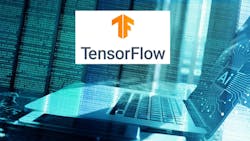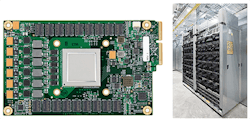Basics of Design: What is TensorFlow?
What you'll learn:
- The key ingredients of TensorFlow.
- How TensorFlow conceptually makes ML models.
- Where to learn more about the platform.
TensorFlow was created simply to develop your own machine-learning (ML) models. You might even experience it daily and not know it, like recommendation systems that suggest the next YouTube video, image recognition, or voice assistants. But what is TensorFlow, how does it work, what hardware does it use, and why is it a major tool for machine learning?
Google built TensorFlow, an open-source software library, for machine-learning and deep-learning applications, designed for developers. Computers learn from these AI models for pattern recognition and data predictions. Developers have leveraged TensorFlow's framework to achieve more efficient model development and training. The tool comes loaded with features to help with quicker, potentially more intelligent application builds.
The Mechanics of TensorFlow
Think about the name, TensorFlow. It gives us a pretty good idea about how it works. A tensor is a multi-dimensional data array, like a grid, that stores numbers representing a string of text, an image, an audio waveform, and much more.
Meanwhile, the flow indicates how that data passes through a sequence of operations — known as a computational graph. Every node represents a mathematical operation, while each edge represents the flow of data between those operations. Putting those together, TensorFlow essentially allows tensor data to pass through networks of mathematical functions.
Such a structure breaks large, complex models into smaller, more efficient steps for processing. It outputs a result that distinguishes between objects in an image, such as a cat and a dog.
TensorFlow gained popularity partially due to its advanced research support, flexibility, and scalability. It runs on a laptop for experiments and can scale up to thousands of servers working in parallel — ideal for hobbyists and enterprise AI systems. Besides the core library, Google and the open-source community developed a rich ecosystem around it.
For instance, Keras has a simple interface, allowing developers to enter a few lines of code to produce neural networks. Teams can use TensorBoard to track metrics and visualize model training progress. With TensorFlow Lite, mobile and embedded devices can run ML models directly on the device. This enables features like voice recognition and other applications to work efficiently without needing a constant internet connection.
Moreover, developers use TensorFlow.js to run models in a browser with JavaScript. And fully developing and deploying ML pipelines can be done through TensorFlow Extended.
Training a TensorFlow Model
How do developers train a model in TensorFlow? They design a model architecture, which determines how data flows through layers of mathematical functions. Then, they provide it with training data that serves as examples for the models to learn. The framework relies on optimization algorithms (powered by automatic differentiation) to adjust the model's internal parameters.
TensorFlow uses Automatic differentiation to compute gradients for optimization, eliminating the need for manual complex math, like calculus and linear algebra. That way, developers can design solutions instead of inputting equations. After training, it's tested on new data to evaluate its accuracy. If performance meets expectations, it's deployed into real-world applications.
The following video is a truncated real-world use of TensorFlow. If you follow the video to TensorFlow’s YouTube page, you’ll find many more examples of how people have used it for their projects. So many inspiring stories, too.
Extended Hardware Support
Additionally, TensorFlow offers high performance due to its support for various hardware platforms, since machine learning demands extensive computation. It uses CPUs for smaller models, experimentation, and production systems that don't need heavy parallel processing. This also means anyone with a CPU can work on a TensorFlow project from their desktop or laptop.
Moreover, TensorFlow excels with its ability to use GPUs for handling massive, large-scale parallel mathematical operations, making it practical for training deep-learning models.
Beyond that, Google developed tensor processing units (TPUs) to handle ML tasks (Fig. 1). TPUs accelerate training and inference, enabling large models to run efficiently at scale. These are utilized in data centers, and developers can access them through Google Cloud. Thanks to this flexibility, developers are able to rapidly prototype models and scale them into production without re-coding them for different hardware.
All sorts of everyday products use TensorFlow, including smartphone voice assistants. Your voice waveform is processed by TensorFlow models when you speak to Siri or Google Assistant. Afterward, it's transformed into a tensor before moving through layers of neural networks trained on millions of voice samples. Those models categorize sounds into words, understand intent, and output a response.
Google Photos also relies on TensorFlow for image recognition, which can organize photos. Even healthcare workers use it for disease detection during medical scans (Fig. 2).
TensorFlow: A Widely Adopted Tool for AI
Overall, TensorFlow makes the complex mathematical operations behind machine learning simpler to work with while giving developers more control as needed. It comes with a full workflow, from designing and training a model to scaling it across hardware and deploying it in production. The powerful computation, flexibility, and extensive ecosystem of tools allowed TensorFlow to become a widely adopted platform for AI applications.
This is just an overview, of course. I plan to try TensorFlow to automate some tedious formatting we must do when preparing an article for publication. Hopefully, I will find some time to share this journey with you all here at Electronic Design.
Oh, how much does it cost? It's free, on a trial basis. If you want to deploy it somehow, there appears to be various pricing options, but none of that is available publicly. Once I get involved with the trial, I will report back.
However, TensorFlow's popularity has waned significantly in recent days. What took its place is PyTorch. ChatGPT even uses PyTorch now. Next up, an overview of PyTorch… stay tuned.
About the Author
Cabe Atwell
Technology Editor, Electronic Design
Cabe is a Technology Editor for Electronic Design.
Engineer, Machinist, Maker, Writer. A graduate Electrical Engineer actively plying his expertise in the industry and at his company, Gunhead. When not designing/building, he creates a steady torrent of projects and content in the media world. Many of his projects and articles are online at element14 & SolidSmack, industry-focused work at EETimes & EDN, and offbeat articles at Make Magazine. Currently, you can find him hosting webinars and contributing to Electronic Design and Machine Design.
Cabe is an electrical engineer, design consultant and author with 25 years’ experience. His most recent book is “Essential 555 IC: Design, Configure, and Create Clever Circuits”
Cabe writes the Engineering on Friday blog on Electronic Design.



